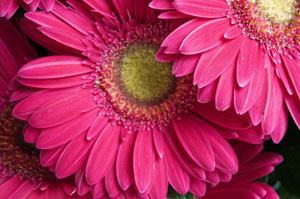Gerbera
 Gerbera, also known as the African daisy, Transvaal daisy, or Hilton daisy. It is a flowering perennial plant related to the sunflower and attracts birds, bees and butterflies. It is also often used as an ornamental plant when deer are a problem, as they will not eat it.
Gerbera, also known as the African daisy, Transvaal daisy, or Hilton daisy. It is a flowering perennial plant related to the sunflower and attracts birds, bees and butterflies. It is also often used as an ornamental plant when deer are a problem, as they will not eat it.
Description
The stems grow from a basal clump of dark-green leathery leaves to about 18 inches, or sometime even 30 inches, in height. The blooms are four inches across and resemble large daisies. They come in red, orange, yellow, pink, white and cream colours and can continue flowering for six months.
Habitat
Gerbera are native to South Africa and are also found in the wild in Madagascar and Asia. They grow on grasslands, rocky slopes, the veldt and in sandy soils. They thrive in full sun or partial shade in tropical, subtropical and temperate climates and are very tolerant of infertile soils but do not like temperatures below about 7 degrees C.
Availability
While Gerbera come in a variety of shapes, there are four main groups: single flowers with a row of non-overlapping petals and a green centre; double or duplex with a double row of overlapping petals with a green, black, or dark red eye; crested doubles containing two rows of overlapping petals with one or more inner rows of shorter petals with a green, black, or dark red eye and full crested doubles which have solid overlapping rows of petals with an inner row reducing in size and covering the eye entirely.
Species
Gerbera belongs to the Compositae /Asteraceae genus, one of the largest plant families. There are about 30 to 40 species of Gerbera. Commercial breeding started in the 19th century when the Gerbera jamesonii species from Natal in South Africa was crossed with Gerbera viridifolia from the Cape Province. It was cultivated first in Europe and later planted in the Himalayan foothills in Kashmir at heights between 1,300 and 3,200 metres.
Care Tips
Gerbera needs a well-drained soil in a sunny spot in the garden. It responds well to a standard fertiliser. Prolong the blooms outdoors by dead-heading.
In pots indoors, it is best grown in an equal mixture of peat, compost and sand. It is prone to aphids, so use a pesticide outdoors and indoors and wash the leaves with mild soapy water once a month to keep pests away.
Did You Know?
The name comes from a 19th-century German naturalist, Traugott Gerber, who was a close friend of the Swedish botanist Carl Linnaeus
References
http://www.bbc.co.uk/gardening/plants/plant_finder/plant_pages/4226.shtml
http://www.thesun.co.uk/sol/homepage/features/4107578/Gardening-how-to-grow-your-gerberas.html


